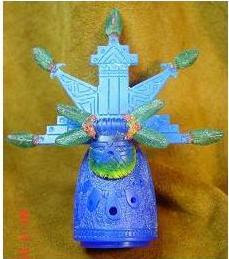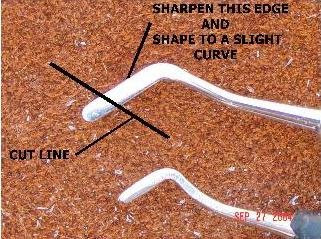I was creating large copper embossed pictures way too many years ago. I found that I could use the copper as a mold in which I would pour about ¾ inch of plaster. I would then finish the plaster to look like the copper. I was selling this pictures in local gift shops.

 This picture is around 18 by 36 inches.
This picture is around 18 by 36 inches.I was looking for a more permanent medium to create theses pictures when I discussed the problem with my buddy, Dee Morris. He suggested I look into lost was casting. Needless to say I asked what the heck is lost wax casting.
After an explanation of the process Dee gave me a hunk of wax. I carved a buckle or bola and he cast it for me.
WOW!!! I had a way to create jewelry. I never created another copper picture.

ORIGINAL BUCKLE/BOLA
That led to a casting class with the Phoenix adult class. I found I could pour molten wax into the copper molds. I created a cowboy portrait buckle. I had it in a shop. A Doctor from New Jersey bought it and wanted to see all my work. By then I has seven designs. He ordered 10 each.

That was it. I was off and running and never looked back. I taught myself to solder, cut stones and make southwest jewelry. Eventually I added the pottery line.
By the way the original piece has been a bola and a buckle several times. I still have it and it is currently a buckle.




 The jump rings are wrapped around a ½ inch wood dowel.
The jump rings are wrapped around a ½ inch wood dowel. To solve this problem I tightened 4 nuts on a number 8 screw so that all the flat edges of the nuts matched. Coated the nuts with crazy glue. Drill a hole slightly smaller in diameter than the screw in one end of the larger dowel. Make sure the hole is centered on the center of the dowel. Place some epoxy or gorilla glue in the hole. Place a flat washer on the screw and screw it into the hole until the washer bottoms on the dowel. I wrapped soft wire around the end of the dowel to insure the screw would not break out during the wire turning process.
To solve this problem I tightened 4 nuts on a number 8 screw so that all the flat edges of the nuts matched. Coated the nuts with crazy glue. Drill a hole slightly smaller in diameter than the screw in one end of the larger dowel. Make sure the hole is centered on the center of the dowel. Place some epoxy or gorilla glue in the hole. Place a flat washer on the screw and screw it into the hole until the washer bottoms on the dowel. I wrapped soft wire around the end of the dowel to insure the screw would not break out during the wire turning process. Cut a slot the width of the wire diameter in the end of the dowel . Cut it about twice the wire diameters into the end of the dowel.
Cut a slot the width of the wire diameter in the end of the dowel . Cut it about twice the wire diameters into the end of the dowel.
 Bend a 90 degree tab in the wire that will be used for the jump rings. The tab should be shorter than the diameter of the dowel. A wire sticking out of the dowel on the side opposite the wire bend will tear a finger during the turning process.
Bend a 90 degree tab in the wire that will be used for the jump rings. The tab should be shorter than the diameter of the dowel. A wire sticking out of the dowel on the side opposite the wire bend will tear a finger during the turning process. Place the screw into the chuck of a variable speed drill. Slip the wire tab into the slot in the dowel. Put a glove on the hand that will be used to control the wire on the dowel. Place your gloved hand on the wire and hold the wire tight against the dowel. Turn the drill on a very slow speed. The gloved hand will guide the wire onto the dowel as it forms a coil.
Place the screw into the chuck of a variable speed drill. Slip the wire tab into the slot in the dowel. Put a glove on the hand that will be used to control the wire on the dowel. Place your gloved hand on the wire and hold the wire tight against the dowel. Turn the drill on a very slow speed. The gloved hand will guide the wire onto the dowel as it forms a coil.  Caution: Do not wrap the wire to the very end of the wire. The last part of the wire will not bend down onto the dowel and will remain a sharp vertical tab that can cut the gloved hand.
Caution: Do not wrap the wire to the very end of the wire. The last part of the wire will not bend down onto the dowel and will remain a sharp vertical tab that can cut the gloved hand. I slide the coil onto another dowel. I use a jewelers saw to cut the jump rings while they are on the dowel. The jump rings are cut by the saw which is held at an angle to the dowel so that the top of one ring is cut at a time. The remaining portion of the coil can be slid into the saw as rings are cut off.
I slide the coil onto another dowel. I use a jewelers saw to cut the jump rings while they are on the dowel. The jump rings are cut by the saw which is held at an angle to the dowel so that the top of one ring is cut at a time. The remaining portion of the coil can be slid into the saw as rings are cut off. 






 I then cover the conchos with a solder pad. I do not want to heat the pre-polished conchos so I cover them with the solder pad.
I then cover the conchos with a solder pad. I do not want to heat the pre-polished conchos so I cover them with the solder pad. I use a large tip on my acetylene torch. I heat the link joint from below. I use a solder pick to get the solder to flow across the joint.
I use a large tip on my acetylene torch. I heat the link joint from below. I use a solder pick to get the solder to flow across the joint.  I polish the link with my Foredom.
I polish the link with my Foredom. 









 CARVING A CORN MAIDEN KACHINA
CARVING A CORN MAIDEN KACHINA











